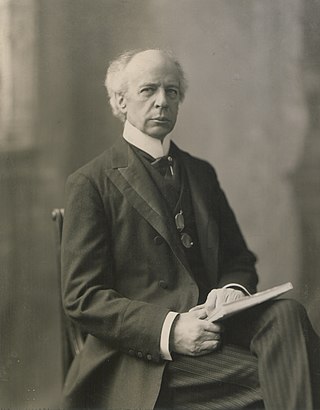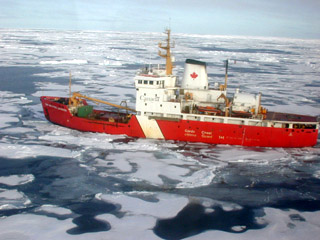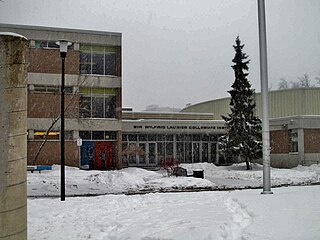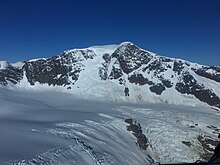
Sir Henri Charles Wilfrid Laurier, was a Canadian lawyer, statesman, and politician who served as the seventh prime minister of Canada from 1896 to 1911. The first French Canadian prime minister, his 15-year tenure remains the longest uninterrupted term of office among Canadian prime ministers and his nearly 45 years of service in the House of Commons is a record for the House. Laurier is best known for his compromises between English and French Canada.

Zoé, Lady Laurier, was the wife of Sir Wilfrid Laurier, the seventh Prime Minister of Canada.

The Winston Churchill Range is a mountain range in the central section of the Park Ranges of the Canadian Rockies located in Jasper National Park. The range was named after Sir Winston Churchill, former British prime minister.

Hewitt Bostock, was a Canadian publisher, businessman and politician.

Mount Macdonald is a mountain peak located in the Selkirk Mountains of British Columbia, Canada, immediately to the east of Rogers Pass in Glacier National Park. It is notable as the location of the Canadian Pacific Railway's Connaught and Mount Macdonald Tunnels. At 14.7 km, the Mount Macdonald tunnel is the longest railway tunnel in the western hemisphere.

The Columbia Mountains are a group of mountain ranges along the Upper Columbia River in British Columbia, Montana, Idaho and Washington. The mountain range covers 135,952 km². The range is bounded by the Rocky Mountain Trench on the east, and the Kootenai River on the south; their western boundary is the edge of the Interior Plateau. Seventy-five percent of the range is located in Canada and the remaining twenty-five percent in the United States; American geographic classifications place the Columbia Mountains as part of the Rocky Mountains complex, but this designation does not apply in Canada. Mount Sir Sandford is the highest mountain in the range, reaching 3,519 metres (11,545 ft).

Sir Allen Bristol Aylesworth, was a Canadian lawyer and parliamentarian.

The Cariboo Mountains are the northernmost subrange of the Columbia Mountains, which run down into the Spokane area of the United States and include the Selkirks, Monashees and Purcells. The Cariboo Mountains are entirely within the province of British Columbia, Canada. The range is 7,700 square kilometres (3,000 sq mi) in area and about 245 km in length (southeast–northwest) and about 90 km at its widest (southwest–northeast).

CCGS Sir Wilfrid Laurier is a Martha L. Black-class light icebreaker and major navaids tender of the Canadian Coast Guard. Built in 1986 by Canadian Shipbuilding at Collingwood, Ontario, Canada, she was the last ship constructed there. The ship has been based out of Victoria, British Columbia.

The Premier Range is a group of mountains within the Cariboo Mountains of east-central British Columbia, Canada. The range is bounded by the Raush River and Kiwa Creek to the north, the North Thompson River on the south and west and the Fraser River and its tributaries to the east.
Mount Mackenzie King is a peak located in the Premier Range of the Cariboo Mountains in the east-central interior of British Columbia, Canada. The mountain separates the Laurier Glacier to the north from the David Glacier to the south.

Sir Wilfrid Laurier Collegiate Institute, initially known as Guildwood Secondary School is a high school in Toronto, Ontario, Canada. It is located in the Guildwood neighbourhood in the southern part of the former suburb of Scarborough. It is named in honour of Sir Wilfrid Laurier, the seventh Prime Minister of Canada. The school was established by the Scarborough Board of Education, and is now part of the Toronto District School Board. The motto of the school Hoc Tempus est Tibi which translates into English as "This Time is for You".
Laurier is the French word for the laurel plant, and is a francophone family name, common in Canada.

This article comprises three sortable tables of major mountain peaks of Canada.
Mount Talbot is located on the northern side of Shale Pass on the Alberta-British Columbia border. It was officially named on 4 November 1925 after Senator Peter Talbot (1854-1919), an early pioneer of the Lacombe region of central Alberta. A teacher and farmer, he turned to politics and became an elected representative of the Northwest Territories and later the province of Alberta. In 1906, Sir Wilfrid Laurier appointed him to the Senate of Canada.
Laurier is a census-designated place in Ferry County, Washington that neighbors the Canada–United States border. The nearest school district is Orient School District. According to the 2010 census, Laurier had one permanent resident.
Mount Sir-Wilfrid is located in the Montagne-du-Diable Regional Park, south-east of the Baskatong Reservoir, in the Hautes-Laurentides region, in the municipality of Ferme-Neuve, in Antoine-Labelle Regional County Municipality (MRC), in Laurentides (region), in Quebec, in Canada.














